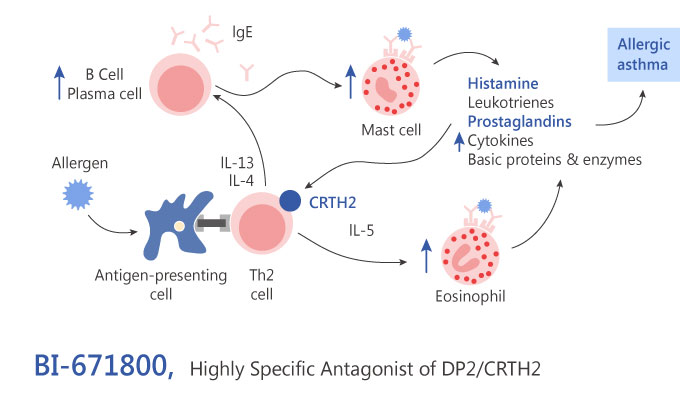Atopic dermatitis (AD), also known as atopic eczema, is a type of inflammation of the skin (dermatitis). The disease typically begins in early childhood, and patients usually develop into atopic diseases such as asthma and allergic rhinitis. Clinical features of AD include severe itching, chronic eczema lesions, epidermal thickening, and hypertrophy. Histological examination reveals an inflammatory infiltrate consisting mainly of memory CD4+ T lymphocytes. Additionally, chronic lesions also display increased mast cells, eosinophils and IgE bearing Langerhans cells. Polyvalent antigen aggregates antigen-specific IgE and induces mast cell activation. Therefore, signaling cascade is triggered and arachidonic acid metabolites, cytokines and chemokines are generated. The major arachidonic acid product made by mast cells is prostaglandin D2 (PGD2). DP1 and chemoattractant receptor-homologous molecule expressed on Th2 cells (CRTH2) are PGD2 receptors.

CRTH2 binds PGD2 with nanomolar affinity and is expressed by Th2 T lymphocytes, eosinophils and basophils. A study from Stefen A. Boehme, et al. identified a small molecule CRTH2 antagonist, BI-671800. BI-671800 is a highly specific and potent antagonist of DP2/CRTH2, with IC50 values of 4.5 nM and 3.7 nM for PGD2 binding to CRTH2 in hCRTH2 and mCRTH2 transfected cells, respectively. The antagonist has potential for the treatment of poorly controlled asthma due to its excellent activity in vitro and in vivo.
Firstly, BI-671800 exhibits low nM potency as an antagonist of human or mouse CRTH2 in transfected cells. And in vivo, BI-671800 (0.1-10 mg/kg, i.g.) shows significant inhibition of AHR in 6-8-week-old age- and sex-matched BALB/c mice. Furthermore, the compound effectively blocks edema formation and greatly reduces the inflammatory infiltrate and skin pathology observed in drug vehicle-treated animals.
Fortunately, BI-671800 has entered into clinical trials, but the result was not satisfied. There is so much more to do.